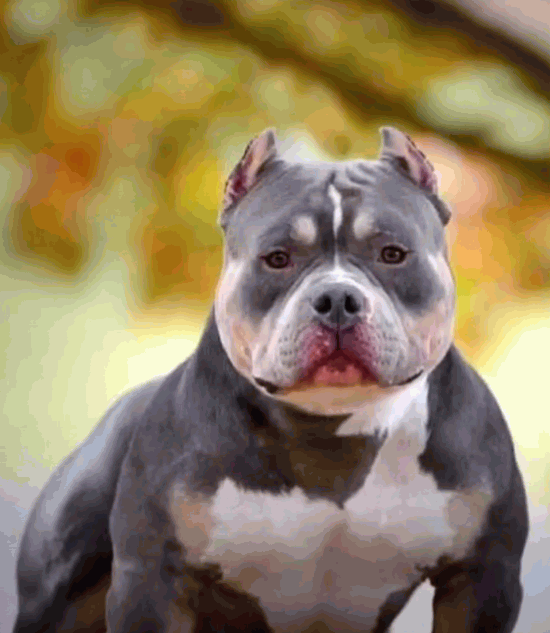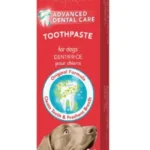Tri color bullies have coat color variations which are strikingly appealing. They are rare, and most dog lovers are looking for tri colored bullies, but how much do you know about them? We had brierfly discussed tri color bullies, but this guide contains everything you should know. The different types their dietary needs, lifespan, and more.
Are Tri Color Bullies a New Breed?
No, they are not. Tri color bullies have become quite popular over the past few years, and people assume they are a different breed, separate from the regular bullies. They are not.
First, you need to understand that most kennel clubs do not regard American Bullies as a breed. The few that recognize American bullies do not consider tri-colored bullies as different. Rather, they consider their color American bullies as bullies with different color combinations in the breed.
What is Different with Tri Color Bullies?
The only difference is the color. Otherwise, nothing is much different with tri color bullies from regular bullies. American bullies are friendly, sociable, and have an even temper, as do tri colored bullies. However, like any other breed, your tri color puppy will also need proper dog training and socialization training. It will also need play, exercise, and attention.
How Big Do They Get?
According to AKC, there are four recognized tri color bully sizes:
- Pocket bullies, which are between 14 and 17 inches tall, and weigh 20 to 65 pounds
- Classic bullies, 17 to 20 inches tall, and weigh 50 to 70 pounds
- Standard bullies, 17 to 20 inches tall and 65 to 85 pounds heavy
- XL Bullies that are 20 to 23 inches tall and weigh 85 pounds or more.
There are other types of bullies. For example, the XXL Amercian bullies are larger than the American bully. They are more than 23 inches tall and remain unrecognized because they come with some health concerns because they tend to be very heavy, and the weight puts pressure on their organs and joints. Consequently, they have a shorter lifespan and low-quality life.
Another type of bully is the micro bullies, also known as exotic bullies. They are taller compared to pocket bullies and result from crossbreeding with Patterdale Terriers. Due to their small body size, they have additional health concerns.
The Three Colors in a Tri-Colored Bully Coat
American bullies come in different sizes and shapes and now in different color tones. Contrary to popular belief, you will not necessarily get tri-color puppies when you cross two tri-color bullies. Any tri-colored bully coat has three main colors—Tan points, base color, and color white.
Tan points
Tan points are what makes tri colored bullies rare. The Tan point gene is the gene that gives bullies the tan on the muzzle, eyebrows, chest, under the tail, paws, or legs.
In reproduction, the recessive genes will be suppressed if one of the two parents fails to pass them on. Therefore, both parents need to have the gene, failure to which the tan point will not show. So, if one parent has the gene and transfers the tan point, but the other does not, the offspring might not show tan points but can produce pups with tan points in the future.
Also, while the gene can come from either side of the family, the gen can be masked by some genes, and the tan points m, may fail to be visible. So, they can be there, but they may not be visible. In this case, it is a ghost tan. A ghost tri American bully has faint tan points, which could sometimes become more noticeable once the dog matures.
Base Color
All tri color bullies have a base color usually seen on the majority of their body. The base color can be white, black, blue, chocolate, etc. However, some patterned coats can be the base colors. For example, a Merle tri color bully can have several colors viewed as the base color.
White
A tri color bully will have white color, especially on the tummy, chest, and neck. However, the white color can sometimes extend to other areas. A bully without the color white will be disqualified from being a tri color bully. It is not uncommon for some bullies to lack the white color even when both its parents are white. In this case, it is considered a bicolor bully.
Tri Merle Bullies:
These are tri color bullies with a distinct pattern. They have some patches where their fur is mottled and have a different color, which adds a third color. Most Merle tri color pit bulls have a blue, fawn, or red base coat. Despite having three colors, the UKC does not consider them true tri colors. Although tri merle bullies fetch a good price, most breeders avoid them because they have inferior health compared to other bullies.
Different Tri Color Bullies’ Colors
Black- it has a black base coat, tan points, and white markings
Choco- they are chocolate brown, with some tan points and white markings
Blue- they have a silver-gray base color, tan points, and white markings
Lilac- these bullies have a light gray base, with some tan points and white markings
Pattern tri bullies
Creeping tan- these are bullies whose tan points appear to grow in size as their base colors retreat. The tan points appear to grow because of a tan point gene mutation.
Trindle- they have tan points, but these points are brindle markings. Trindle bullies are the best picks for pet owners who like tri but also are fans of brindles.
Ghost tan- the tan points, though present, are not visible and are sometimes invisible or consist of a few tan hair tufts in tan point areas.
Tri Merle bullies- their Merle coat results from a genetic mutation that affects their pigmentation. The gene mutation causes lighter patches on their coat which appear attractive. It is not suitable to breed parents with merle genes because they could give birth to a pigmented
What is the Cost of Tri Color Puppies?
There are different costs of tri color puppies depending on their size, bloodline, color, and build. Here is a table with the range of prices for each variant.
| Variant | Price Range |
| Black | $4000 to $6000 |
| Blue | $5000 to $7000 |
| Choco | $5000 to $7000 |
| Lilac | $8000 to $12000 |
| Ghost | $10000 t0 $15000 |
| Piebald | $6,000 to $8,000 |
| Brindle | $6,000 to $8,000 |
Are there Health Concerns for Tri Colored Bullies?
Yes. While the trio colored bullies are a healthy breed option, there are prone to some health issues. The first is hip dysplasia. Hip dysplasia is common for dogs and is an issue that develops when the hip joint or thigh bones do not develop correctly. Unfortunately, it is not curable. However, it is only common for dogs whose parents had the disease.
Second, they are prone to Demodex mange, an illness which targets the light-colored fur and weakness them, causing the fur to fall off. So, the dog develops some bald patches on its coat. Tri color bullies are also prone to hypothyroidism which causes muscular weakness, hair loss, weight gain, and lethargy.
Lastly, tri color pit bulls are prone to gastric issues like gastric dilation and torsion. Gastric dilation is common among large dogs that have deep chests. It is less worrying and can be easily resolved when a dog eats slowly. On the other hand, gastric torsion is a severe case where the stomach gets twisted, interfering with the blood flow to the digestive system. Gastric torsion demands immediate medical attention.
Can I breed Tri Color Myself?
Not everyone can breed tri-colored bullies. If you meet the requirements for an ethical breeder, then you can. Nevertheless, breeding is not a fun DIY experiment. As an ethical breeder, you need to meet numerous requirements and will be under several obligations. You need to prioritize your dog’s welfare. Also, you need to have basic knowledge of breeding and genetics to know which combinations work well and which don’t. Additionally, you should work alongside a vet.
Yes, tri color bullies and puppies fetch good prices, but dog breeding is not a self-employment venture. Therefore, if you love American bullies and want to own a tri color, getting one from a breeder is better, safer, and cheaper.
7 More Things You Need to Know
Here is more information on tri color pitbulls:
Training
They are easy to train because they like pleasing their parents. So, for them, training is a fun activity. Additionally, they like receiving attention, and the reward, treats, and encouragement that come with training will make it easier for them.
Exercise
Like other dogs, it is important for your tri color to get the exercise they need. Since they are very energetic and lead a high-octane lifestyle, they need 2 hours at least of activity every day. You need to tire your pitbull, or the pent-up energy might cause it to be destructive. They could chew, claw, and dig around to fight boredom. Here are the top indestructible toys you should consider giving your dog.
Grooming
Fortunately, pit bulls, including tri color pit bulls, are low maintenance. They rarely shed their fur, and their coats remain clean with minimal effort. Nevertheless, you need to occasionally brush and clean them to keep their fur and coat looking clean and tidy. When cleaning your dog, use a damp towel and bathe him using mild shampoo instead of soap.
Dietary needs
With their intimidating muscles and strong bodies, ensure your feed your bull with lean protein. They need healthy nutrients to maintain their appearance and stay within normal weight.
Allergies
A popular myth is that tri color pitbulls are hypoallergenic. They are not. They shed moderately. However, their loose hair had dander, which some might find irritating. As pit bulls drool a lot, and their saliva could be an allergen.
Lifespan
tri colors have the same lifespan as other pit bulls. They live between 8 and 16 years, depending on their health and other factors.
Adoption
Due to the rareness of the breed, tri color pitbulls are hard to come across in rescue centers and dog shelters. However, you can find a tri color pitbull from a breeder near you.
Tri Color Pitbull for Sale
Are you constantly wondering where to find cheap tri color pitbull for sale near me?
- For Tri-Color Pitbull for Sale In Michigan
- Tri color pitbulls for sale in Georgia
- Tri color bullies in California
Reputable Tri Color Bullie Breeders:
Take Away
Tri color bullies are beautiful, but the bottom line when owning a dog is getting a staunch companion. There are numerous tri colored bully puppies for sale all over, but if you cannot find one, you can always settle for another breed as you wait on a bredder to work on getting one for you. If you’re lucky enough to get one, you will love the individualism and special colors of a tri color bully.
FAQ
Are Tri pitbulls good family pets?
Yes, tri colored bulls are ideal for family life because they are gentle, energetic, playful, and caring. They are good with children, friendly and affectionate.
When is a Dog Classified as a Tri Color?
A dog is considered a tri color bully when it has tan points, a base color, and color white.
What is a tri carrier bully?
It is a dog that carries the tri color gene, although it does not display it.
What is a tri bully pit?
It is a Pitbull variant whose coat has three colors.
Do Tri Color Pitbull Puppies Color Change as They Grow?
The puppies might slightly change their color as they grow. Usually, a newborn doesn’t have enough melanin. The puppy’s body produces more melanin as it grows, resulting in bigger or new dark patches.
What is a Reverse Tri Color Bully?
It is a sable tri color. A sable refers to a dog with light fur and black tips.
Are tri color bullies rare?
Yes. Tri colored bullies are rare because most general breeders were not previously focusing on making them until recently. So, it is a rare species. Also, the gene creating three colored coats is recessive, and most parents must have it to make tri color puppies.
Which is the rarest tri color bully?
Blue is the rarest color.
What does lilac mean?
Lilac, also blue coats, look somewhat silvery or deep gray. The color comes from the inheritance of recessive genes.
How big can tri color bullies get?
Most weigh between 30 and 60 pounds, with the males being larger compared to the females. However, the smaller males are smaller than females, so you cannot use size as a good indicator of gender.
Is my bully a tri colored bully?
The only way to be sure is to check the pup’s family tree. If you would like a tri color bully pup, it is best to ask a breeder to save one for you.
Where can I get a Merle pitbull?
You can easily get one from a breeder. They are a rare type that does not occur naturally. So, breeders pick dogs with the Merle gene and breed them. The Merle pitbull puppy is expensive, as one could cost thousands of dollars.
How much does a tri color bully cost?
They will cost anything between $2000 and $5000 depending on the color, age, breeder, breeding quality, etc. However, those not pure breeds may cost between $500 to $800.
Are Champagne tri considered tri color bullies?
This is controversial because purists insist that champagne-colored bullies are not tri color because champagne and tan are the same color, just in different shades.





